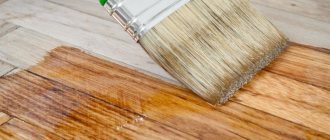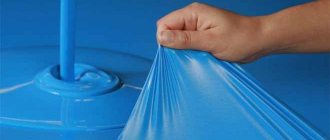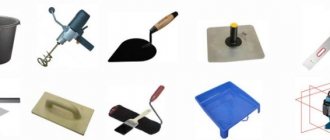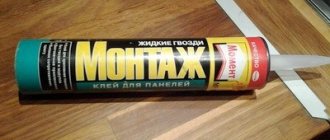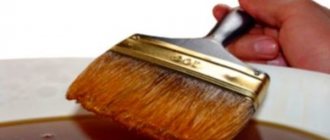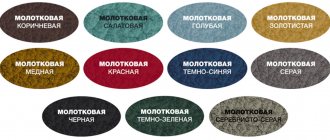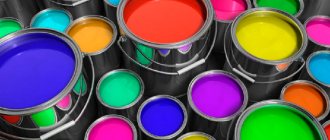Paint and enamel - the main differences between the compositions
Paint and varnish compositions are used to protect the material to which they are applied and to create a film that has a decorative function. This coating is highly resistant to negative environmental influences. Paint and enamel are produced in different forms, allowing you to choose the most suitable option in accordance with your requirements.
Composition of paint and enamel.
Terminology and composition
Mixtures are used to obtain decorative coatings that are resistant to the external environment. At the stage of preparation for repair work, it is necessary to take into account the difference between enamel and paint :
- The first is a complex of coloring pigments distributed in a mixture of varnish, filler and targeted additives. After application to the surface to be treated, the material creates a dense, opaque film characterized by high protective characteristics. During production, preference is given to film-forming substances, which makes it possible to reduce the content of fillers in favor of increasing decorative properties.
- The second is a set of pigments contained in a mixture of fillers, targeted additives, oil, latex, and drying oil. After drying, the material forms a dense opaque film.
Despite the differences, paint and enamel have quite similar compositions. They contain fillers, pigments, solvents, targeted additives and film-forming substances that are responsible for the formation of a uniform, dense coating with high protective properties on the surface being treated. This group of substances includes polymerization resins, varnishes, epoxy and alkyd resins, and shellac.
Coloring pigments, added to paints and varnishes in powder form, mostly contribute to creating the necessary visual effects when painting walls and ceilings. In isolated cases, pigments are not only responsible for the color of the material, but also have a protective function, for example, when using iron oxide substances to prevent corrosion.
Insoluble fillers are included in the overall composition of the material in order to improve its technological characteristics and increase its volume.
Targeted additives are contained in paints and varnishes in small quantities. They are used to correct the curing time of the coating, the thickness of the material, and prevent the formation of a dense sediment that cannot be stirred.
Solvents included in the material are capable of dissolving the film former, which allows the viscosity to be affected. Popular representatives of the group are white spirit and solvent.
Benefits and Features
For some reason, many people think that enamel paint and enamel are the same thing, but this is completely wrong. Enamel is a glass-type coating that contains quartz particles, metal alkali, pigments and other components. When an enamel coating is applied to a surface, it is heat-cured to make the item durable and resistant to wear. This material is often used to cover ceramics, dishes and bathroom surfaces.
Enamel paints are a watery or gel-like product that contains an organic type solution that creates a film on the surface. This process occurs due to the presence of alkyd resin in the varnish composition. Certain manufacturers use other components, but with similar chemical properties.
After the paint dries, a dense film appears on the base, which performs a protective function and increases resistance to surface wear. It protects against abrasion, small scratches, water and dirt due to its repellent properties. This point is extremely important for most women who hate or do not want to spend a lot of time on the cleaning process. The enamel-coated surface simply needs to be wiped with a damp cloth, and it returns to its original appearance.
Another great advantage of enamel paints and varnishes is their beautiful shine, which will give the base a beautiful, rich appearance. This property depends not just on the film former, but on specialized additives. Most professional painters prefer to paint surfaces with enamel compounds - they are easy to work with, they are easy to apply and lay down in an ideal layer. They should be applied to primer, wood and metal.
Enamel paints and varnishes can be applied in one layer, and modern manufacturers offer a wide range of such materials that have a different color palette. All customers can choose their colors depending on the required shade and preferences. The affordable cost of goods gives enamel paints and varnishes a higher value than their oil counterparts.
In addition to many advantages, such paints have nuances that are important to consider when purchasing. A huge disadvantage will be a sharp and toxic aroma, which is not found in simple paints.
It is necessary to work with such varieties carefully, and you also need to wear a respiratory mask to protect the body from toxic poisoning. Jars must be stored in a special way; they should only be kept upright and away from small children.
Types of enamel coatings
Mixtures are usually classified according to the criterion of the substances included in the composition that affect the technological characteristics of the material.
The composition of enamel paint allows it to be divided into:
- To alkyd, characterized by ease of application, durability, high resistance to humidity and temperature changes. Alkyd enamels dry quickly and can be used for exterior and interior use.
- To nitrocellulose, used to treat surfaces made of wood, concrete or metal. The cellulose nitrate included in the composition provokes the appearance of a pungent odor. The difference is that this type of mixture is produced only in aerosol cans or cans, and compatibility with other materials is negative.
- To silicone, creating a high-quality coating on any surface. This paint is resistant to ultraviolet radiation, moisture and temperature. The difference with the properties of other types of enamel products comes down to the possibility of combination only with dry acrylic coating.
- On oil, glyphthalic, which is considered a combined material that is compatible with alkyd, epoxy and acrylic paints.
- To acrylic, made on the basis of latex in combination with a water dispersion. This type is compatible with all water-based paints and varnishes. If necessary, additional work can be carried out to combine acrylic enamel with paint on a different base.
- To alkyd-urethane, characterized by high coating strength and resistance to natural wear. An additional advantage of the material is the possibility of its application on surfaces that were previously painted using paints and varnishes based on epoxy resin and oils.
Types of enamel paints and methods of applying them
Before purchasing a certain type of enamel paint, you should find out about the types of such compositions.
The main ones include:
- Organosilicon. This type of enamel can be applied almost anywhere, as they are resistant to wear and moisture. But it is worth remembering that they are compatible with acrylic coatings.
- Urethane. This type can be applied to an oil base, so it is perfect for renovating a room where the old paint could not be removed. Such compositions are characterized by increased strength.
- Nitrocellulose. Such enamels are used when painting concrete and other materials. Without the use of additional additives they are not compatible with other coatings.
- Pentaphthalic and glyphthalic. They are considered a type of oil paint.
- Acrylic. With proper surface preparation, they can be used when painting any walls that have an old coating. This allows you not to think about compatibility with many compounds.
It is worth remembering that applying oil paint to nitro enamel is unacceptable, since when these substances interact, the coating begins to swell and curl.
How to apply alkyd enamel to paint
Before you start repainting the walls in your home, you need to prepare the surface, as dirt interferes with the distribution of the enamel and contributes to the deterioration of the final result. But if you cannot completely remove oil paint, you should:
- Check the surface of the previously applied coating. All loose parts must be removed and then the surface sanded with sandpaper.
- Wash the surface with water to which soda has been added. After application, all this should be thoroughly rinsed and allowed to dry completely.
- Dilute the enamel with white spirit and stir. You only need to add 2%.
- Apply the composition in three layers. Each subsequent action should be performed only after the surface has completely dried.
Features of painting with enamel compositions
To get a smooth surface, you must first heat up the enamel paint and then get to work. Thanks to this, they begin to be evenly distributed over the surface, leaving no streaks. To warm up the paint, just put it in hot water. After this, the composition is mixed and applied with the selected tool.
Enamel paints can be designed for both spray and brush use. If you use the wrong tool, the result will clearly not satisfy you.
You should also be careful about surface preparation. If this is a wall that had an old coating, then it should be washed thoroughly. If the paint still remains on the surface, shading with water is applied and the paint begins to be applied to the wall, which has not yet dried.
When using a roller, special attention is paid to the corners where such a tool is not able to properly paint the surface. If you have not done this before, then it is best to use a spray gun, thanks to which the composition is evenly distributed over the entire area of movement of the hand.
The following things should not be done:
- Touch the paint until it is completely dry. Even if you notice a drip, you need to leave it until the paint is hard. The situation can be corrected by removing this part of the coating and then painting it over.
- Work under lamp lighting. This will not allow surface imperfections to be seen.
- Leave any falling drops of paint. If you do not remove the composition from the floor in time, it may harden and will be difficult to remove.
- Work without a respirator and safety glasses. This is necessary, since fumes from alkyd enamels are toxic and cause more damage during application.
- Use paints near fire sources. Alkyd enamels can catch fire easily.
To see how a certain color will look on a surface, just paint a small area of similar material and compare the result with your ideas. This will help determine the required thickness of paint and the distance from the wall to be painted to the sprayer, as well as the quality of the result.
Alkyd enamels and oil paints
Alkyd enamel can be applied to a surface that has already been treated with oil paint.
Oil paints and enamel alkyd enamels.
To get a good result, you need to follow simple rules:
- To achieve high adhesion of paint and surface, the base must be pre-treated by removing dust and grease. If there is an old coating on the surface, it is removed only if it is easily susceptible to mechanical stress or has deep cracks that spoil the appearance. The layer of old paint is removed using coarse sandpaper.
- After removing dust and remnants of the old coating, the surface to be treated is cleaned again. To remove greasy deposits, you may need to use a warm solution of soda and soap. Application of paint is allowed only after the cleaned surface is completely dry.
- A solvent is added to the paint can immediately after opening to reduce the viscosity of the composition. After this, the paint and varnish material must be thoroughly stirred until homogeneous.
- Each layer of enamel paint should be thin. Re-coating is allowed only after the surface has completely dried. The information about how long it takes for enamel and paint to dry, indicated by the manufacturer on the label, is for reference only, since this indicator is affected by the temperature and humidity of the environment.
Alkyd enamel and oil paint can be applied to the surface in three layers, with each subsequent layer being denser than the previous one.
Source: vmirekraski.ru
Disadvantages of oil paints
What is the difference between alkyd paint and enamel? Like other types of oil-based coatings, there are a number of disadvantages:
- Low indicator of both wear resistance and hiding power.
- Long drying time - from several hours to a day.
- If the drying oil in the paint is synthetic, then the paintwork material is toxic, which is why its use inside residential premises is undesirable.
- A thick layer of oil paint blocks air access to the base, so the coating may end up in a network of cracks.
- Drying oil becomes yellow over time, which spoils the aesthetic appearance of the surface.
However, despite the above, oil paints continue to be in demand, primarily due to their low cost and versatility. If this coating is applied correctly and the surface is not subjected to mechanical stress, then this coating will last up to 7 years.
General information about paint
Basic composition of enamel paint
- White spirit and solvent;
- Varnish;
- Various additives that improve properties;
- Fillers;
- Pigments that affect color.
Enamel paint successfully copes with the cladding of various surfaces - internal and external. You can paint wood, concrete, metal, brick with enamel. The main thing is to follow the rule of avoiding use in conditions of increased fire hazard, since the composition contains varnish, which is known to be a flammable component.
The performance properties of enamel wall paints are at an excellent level. A distinctive feature of the paint is its ability to protect the rough surface from moisture and aggressive environmental influences. In addition, before starting painting work, there is no need to carry out preliminary surface preparation.
Difficulties in choosing enamel paints for interior work
When you come to a specialized store selling paint and varnish products, before purchasing the product, pay attention to the label and its composition, as well as the texture of the paint itself. The container with the material must be intact, without dents, damage or defects. Remember that failure of the seal will inevitably lead to loss of properties and drying of the paint. In addition, based on this, after the jar is opened, the composition must be used immediately or before the expiration date. It is important not to store an open jar for a long time, otherwise you will have to throw it away anyway. Manufacturers indicate information about shelf life and use on the label of the GOST enamel paint can.
Note. When purchasing enamel paint, carefully study the label and numbers. For interior work, it is unacceptable to use paint that is intended for finishing external surfaces.
Features of using enamel paints
Those who are faced with the need to paint with enamel paints for the first time are wondering: is there a need for preliminary preparation of surfaces? That is, is it necessary to putty the walls or coat the elements with primers? We dare to assure you that there is no need for such manipulations. Enamel paint for exterior use has excellent adhesion to any surfaces and materials, which in turn eliminates the need to putty walls. This rule applies in cases where the surface does not have significant damage or defects.
Before applying enamel paint, simply clean it of various types of contaminants and prime it. Paint applied to ceramic and enamel coatings does not require a primer. Also, it is worth remembering that in some cases it is necessary to use a solvent for enamel paints. Any solvents are suitable for this purpose.
Instructions for using enamel paint
Enamel paint must be applied to surfaces in a special way. Before this, the base is prepared to avoid peeling. If necessary, remove the old paint if you see that it comes off the surface quite easily. If visible traces of peeling are not visible or the old coating is excessively dense, sand it using coarse sandpaper, remove dust and rinse the surface with water, first dissolving soda in it, and then again with clean water.
When the surface is dry, proceed to painting. If necessary, dilute the paint with solvent and mix thoroughly. The enamel must be applied in three layers. Each subsequent one is applied after the previous one has completely dried.
Advantages of enamel paints
Enamel paint is made from chemical components and compounds that are designed to fill pentaphthalic drying oil with special alkyds and resins. This is its main difference from natural paints made with oils and drying oils. Ingredient information can be obtained by reading the label first. The pentaphthal component is designated by the letters PF, the oil elements by MA. Pentaphthal-based PF enamel paint is characterized by a dense, glossy surface, which is why it gained its popularity among consumers.
Enamel paint has a gel-like and at the same time watery structure, with components that form a film on the surface. These processes occur due to the fact that the paint contains alkyd resins or varnish. In addition, manufacturers may use other components during production, but this does not change the chemical properties of the paint.
After the enamel paint for interior work dries, a protective film is formed on the surface, which increases the resistance of the painted surface to wear during mechanical stress, for example, friction, impacts. In addition, it provides protection against water, various types of contamination, and scratches. The enamel surface is simply wiped with a damp cloth without additional means.
Features and Benefits
Many people believe that enamel and enamel paint are the same thing, but this is completely false. Enamel is a glassy coating that contains quartz particles, metal alkali, colored pigment and other components. When a surface is covered with enamel, it is treated in a special thermal way, which ensures the strength and wear resistance of the item. Enamel is often used to cover dishes, ceramics, and bathroom surfaces.
Enamel paint was created by chemists who were able to saturate pentaphthalic drying oil with special alkyd resins. In contrast, ordinary paints are made from an oil-based natural drying oil. Manufacturers mark this point on the label with information about the composition. The presence of pentaphthal is marked with the letters PF, oily materials have the abbreviation MA. The first has a uniform, dense and shiny coating; for many, these factors are decisive when choosing.
Enamel paints and varnishes are a gel-like or watery product containing an organic solution that forms a film. This process occurs due to the presence of varnish or alkyd resin in the composition. Some manufacturers use other components, but with similar chemical properties.
After the paint dries, a dense film is formed on the base, which performs a protective function and increases the wear resistance of the surface. It protects against abrasion, shallow scratches, dirt and water, thanks to its repellent properties.
Another great advantage of enamel paints is their incredible shine, which gives the base a rich and beautiful appearance. This property depends not so much on the film former as on special additives.
Most professional painters prefer to paint surfaces with enamel products: they are easy to work with, they apply well and lay down in an even layer. They can be applied to wood, soil and metal.
Enamel paints can be painted in one coat. Modern manufacturers offer a wide range of these materials, with a varied palette of colors. Any buyer will be able to choose a color depending on the desired shade and personal taste. The affordable price of goods gives enamel paints and varnishes a greater advantage over their oil counterparts.
In addition to so many advantages, enamel paints have nuances that need to be taken into account when purchasing. The big disadvantage is the toxic and pungent odor, which is absent in ordinary paints. You should work with enamel varieties carefully. It is necessary to wear a respiratory mask to protect the body from toxic poisoning. Cans must be stored in a special way. They should stand exclusively in an upright position (as far as possible from children).
Basis and composition of enamel paint
Paint is one of the most popular finishing materials. Enamel is the most popular of its “competitors”. Its popularity is due to its ease of use and pleasant appearance after completion of the work - it produces a beautiful glossy surface, in addition, the cost of this material is quite low. In order for a surface finished in this way to last as long as possible, it is necessary to choose the right paint.
What is enamel paint
This material is one of the types of paint and varnish coatings. The enamel paint contains the following 5 components:
- Varnish;
- Solvent or white spirit;
- Fillers;
- Various functional additives;
- Pigments of a certain color, which should be the shade of enamel paint.
Enamels can be used to perform various works, both external and internal, as they fit well on any surface. Enamel paints are suitable for any materials: wood, metal, concrete and even brick. However, it should be remembered that it is better not to use it in fire hazardous conditions, since the varnish contained in the composition is flammable.
Enamels have good performance properties; they protect the rough surface well from high humidity, as well as from aggressive environmental influences. At the same time, before staining, there is practically no need to prepare, but more on that later.
Purpose and use of wood enamels
A tree, after prolonged exposure to various atmospheric phenomena (rain, snow), begins to gradually lose its visual appeal. Over time, cracks may appear on its outer part. In addition, if a tree is constantly exposed to moisture, then fungi, moss and even mold may appear on it, which poses a considerable danger to human health.
The use of enamels to protect the facades of wooden buildings allows not only to protect wood from moisture and prevent its premature destruction, but also to eliminate or mask the negative consequences that appear on the surface of wooden buildings due to adverse atmospheric influences. For example, enamels for exterior woodwork can not only significantly extend the life of a structure, but also eliminate all imperfections that have appeared on the surface of the wood during its operation.
Wood enamel makes it possible to disguise and eliminate the loss of the natural shade of wood. In addition, the use of enamels makes it possible to prevent the occurrence of various cracks or even small deformations on the surface of the wood.
The main task of enamels and other paints and varnishes that are used to color wood is to provide reliable protection for its surface and repel water. Enamels also have the following beneficial properties:
- Prevents drying out and cracks on the wood surface.
- Repels harmful insects.
- Preserve the decorative characteristics of the building.
It is worth noting that enamels used to paint wood have increased resistance to abrasion. Therefore, if you follow all the rules and nuances for painting wood, you will have to replace and update the already applied enamel no more than once every few years.
Types of enamels
There are different types of enamel paints, so here is a list of them:
- Alkyd enamel is considered the most popular. Alkyd enamel paint has a number of advantages - they are durable, easy to apply, have an elastic structure and dry quickly. They are very often used in rooms with high air humidity, for example, in bathrooms or swimming pools, as they tolerate temperature changes and moisture. Alkyd paint, like any other, has its own designation so that it can be easily found, for example, with a penta-flannel base, it is designated as PF-253. The numbers also have their meaning, the first number is the purpose, therefore, 1 is for external work, 2 is for internal work. The last 2 digits are the catalog number;
- Nitroenamel - the basis of this type of enamel paint - is cellulose nitrate. Their peculiarity is that they dry almost instantly under normal conditions, at room temperature. However, environmental pollution from enamel paints of this type is very high. Therefore, their use in many countries is significantly limited or completely prohibited. Most often they are used for painting wood surfaces. The application of such a coating is carried out mainly using special sprayers; this is done in this way, since quickly drying paint is very difficult to apply using the usual physical method;
- Polyurethane enamels - the main advantage is wear resistance. In this regard, they are used for painting floors in general purpose rooms, that is, with high traffic, for example in school corridors or in museums. On the second day after completion of work, the painted surface is completely ready for use. Remember about safety precautions, enamel paints are toxic, so you need to work with them in special protective equipment - gloves and safety glasses. The room must be ventilated during and after completion of work.
Tips and recommendations for use
In order to protect against oils, dust or other influencing factors, a type such as electrical insulating enamel is used. Due to their brightness, protective and mechanical properties, alkyd paints can be used both outside and inside the car, not only on the entire body. In order to save paint and apply it evenly over the entire surface, a spray gun is used. Thanks to pneumatic spraying, it performs its functions perfectly.
The need for painting often arises during body repairs, after accidents. In order for the effect to be as positive as possible, you need to use the best auto enamels for your car. Resin solvents are used to soften paint.
Varnishing and polishing are essential for many enamels to finish the job.
Calculation of car enamel consumption
There are average indicators for the distribution of auto enamel per 1 m² - a quarter of a liter. To completely paint a car, approximately 2.5 - 3 liters of enamel are spent.
Calculation for car parts:
- rear wing – 300 ml;
- front steal - 200ml;
- front door – 200 ml;
- hood – 500 ml;
- trunk - 400 ml;
- thresholds – 300 ml.
Color Chart
Car enamels have basically two main directions - metallic and non-metallic. Metallics have a pearlescent tint, non-metallics do not. The car paint chart is represented by hundreds of colors, ranging from bright to black shades. Paint is sold in automotive stores in almost any color. Depending on the chosen colors, the effect that it will carry is selected.
Methods of applying auto enamel
Motorists and professionals use various methods of applying paint to cars.
Methods:
- Using an aerosol. This method is best for home dyeing. Alkyd and acrylic are used;
- With special equipment. This method is used to quickly and evenly apply enamel;
- Without equipment, since there are cases when it is not practical to use it;
- Using a pencil for spot application;
How to choose the right enamel paint
The first thing to do is look at the label and the condition of the can of material itself. It is important that the jar is intact and does not have any visible damage, for example, dents and other things. It is important to remember this, because if the seal of the can is broken, the paint will certainly dry out or lose its properties. Secondly, the paint must be used after purchase or within the expiration date, the main thing is not to leave it for a long time, otherwise it will again lose its properties. Lastly, look for GOST on the packaging label; each paint product has its own GOST, so before purchasing, find out the one you need.
Be sure to pay attention to the numbers mentioned above. Thus, you cannot use paint indoors that is intended for painting exterior surfaces. It is best to study all the digital symbols in advance to avoid mistakes.
Enamel paints application and subtleties
The first thing worth mentioning when talking about working with this finishing material is whether it is necessary to putty the surface for enamel paint. On this issue we can say that not at all, enamel has good adhesion to all known materials, so preparation with putty is not necessary. If there are no significant irregularities on the surface, it is enough to simply clean it thoroughly from dust and dirt, and then prime it, and if this paint is intended for ceramics and enamel coatings, then you can do without priming. When it comes to the question of how to dilute enamel paint, we can say with confidence that thinners of any type, as well as a solvent, are suitable here.
Enamel and its composition
The main composition of the enamel includes a varnish of synthetic origin, a filler and a mixture of pigments added to the overall composition in the form of a suspension.
After application and subsequent drying, the enamel forms an opaque film. The texture of the resulting film can be very diverse. This substance is used most often for decorative purposes.
The resulting film on the surface is characterized by excellent strength and elasticity, which allows it to freely perform a protective function. Due to its composition, enamel is significantly superior in its positive qualities to oil and water-based paints.
The decorative effect of this coloring agent directly depends on the proportion of the added components, that is, with a higher content of synthetic varnish, which plays the role of a foaming agent, than filler, the painted surface becomes more textured.
Paint composition and properties
The basis of any alkyd paint is a special varnish and a solvent that allows you to obtain the desired consistency. A variety of fillers that provide certain properties and additives (for example, a protective antiseptic) are also used. Pigments give paint the desired color.
The alkyd-based varnish used in the production of paint can be glyphthalic or pentaphthalic. For the manufacture of paints, pentaphthalic varnish is mainly used, which consists of alkyd resins mixed with vegetable oils, glycerin and rosin. Solvent is added to thin the paint.
The properties of the material depend on the specific type of product. After application and complete drying, it may have:
- increased degree of density of the protective layer;
- excellent water-repellent properties;
- resistance to mechanical damage;
- resistance to aggressive detergents and cleaning agents.
A wide range, affordable price and ease of use are another plus in the treasury of advantages of paints of this type.
It is worth remembering that the toxicity of paint at the stage of its use is quite high; many will not like the strong smell of the material. However, after the treated surface dries, the environmental issue is removed and the harmful effects are reduced to zero.
The presence of solvents in alkyd paints makes them a fire hazard, so operation requires strict adherence to safety measures.
Enamel and its varieties
All enamels are divided into four main types:
- Aerosol. Its distinctive features include a fast drying process.
- Acrylic enamel is intended for both external and internal painting. Can be applied to surfaces made of wood, metal, brick, concrete, plaster.
- Alkyd enamel is used for painting various furniture, windows, and appliances made of metal or wood. Can be used both indoors and outdoors.
- Heat-resistant enamel is used for painting parts exposed to high temperatures.
Depending on the main substance included in the composition, enamel is divided into:
- Pentaphthalic (PF), that is, the base includes pentaphthalic varnish;
- Glypthal (GF), the base is considered to be glypthal varnish;
- Organosilicon (OS) refers to heat-resistant substances;
- Enamels based on nitrocellulose (NC) are resistant to moisture;
- Enamels, which are based on polyvinyl chloride and alkyd resins (CV), are resistant to chemical and atmospheric influences;
- Enamels made on the basis of acrylic enamels (AK) are resistant to light radiation, including ultraviolet;
- Enamels made from alkyd-acrylic varnish (AC) perform an increased protective function for any surface;
- Enamels based on alkyd epoxy resin (EP);
- Enamel based on phenolic oil varnish (PL) has a high level of wear resistance and strength.
Regardless of the type of enamel, it is important to follow the agreed safety measures during operation, since each of the above is highly toxic and prone to instant fire.
Source: www.promo96.ru
Types of enamels
Today, there are different types of enamels, it all depends on the materials used to make them. Depending on the base, there are enamels:
- Alkyd;
- Oily;
- Polyurethane;
- Nitrocellulose.
Before choosing enamel, you should definitely take into account the type of surface on which it will be applied, as well as the conditions of its use.
For example, there are enamels whose film is resistant to oil and petrol and is not susceptible to various aggressive substances. As an example, Enamel HV-125 can serve as a more detailed description of its properties here https://lakokraska-ya.ru/emal-hv-125. At the same time, it is also important to take into account many other operational characteristics, primarily environmental humidity and air temperature.
Nitrocellulose enamel is a suspension of nitrocellulose with plasticizers, a dispersant and a special pigment. This type of enamel can be used for painting metal and wooden surfaces.
Nitrocellulose enamel contains toxic and flammable substances, so it is necessary to work with it away from fire, making sure to protect your hands and respiratory organs. Nitrocellulose enamel is applied using the most common painting tools.
Alkyd enamel is perhaps the most common type of enamel that can be found in many construction markets. The scope of application of this paint and varnish material is very extensive, from the manufacture of furniture to use for various construction and repair purposes.
Polyurethane enamel differs from other types of enamels in its increased wear resistance and immunity to many negative factors. Polyurethane enamels are quite expensive, so they are used only where reliable protection of various types of surfaces is really needed.
Preparation of enamel paints
The preparation of enamels consists of the following operations:
- mixing dry pigment with a binder in mixers,
- grinding the resulting mixture on a paint grinder,
- diluting the resulting paste with varnish or solvent to the required consistency
- package.
When choosing a binder for rubbing paints, it should be borne in mind that the use of rapidly volatile solvents is undesirable. Therefore, the grinding is often carried out using drying oil or linseed oil, diluting it later with varnish. The most common type of mixers are the Werner and Pfley-derer systems, as well as trunk ones.
The binder is poured into the mixer, the pigment is added and stirred until a uniform mixture is obtained. The stirred mixture is sent to the paint grinders for fumes. Three types of paint grinders are used: roller, cone or disk and ball mills. Solvent loss occurs on open roller paint grinders. Depending on the variety, it is passed through rolling 2-4 times.
Cone or burr grinders and ball mills are used for very liquid solvents containing highly volatile solvents. They are not very productive. After rubbing, the paint is diluted with varnish and solvents to the desired consistency.
Recently, single-roller paint grinders have begun to be used to remove debris and large particles. Laval centrifuges are also used for cleaning. After cleaning from debris, it goes to bottling. It is recommended to soak the finished enamel paint before bottling, after which it gives better shine and bottling. Iron containers are not recommended; galvanized or aluminized ones are preferable. It must be airtight; contact with air must be excluded.




